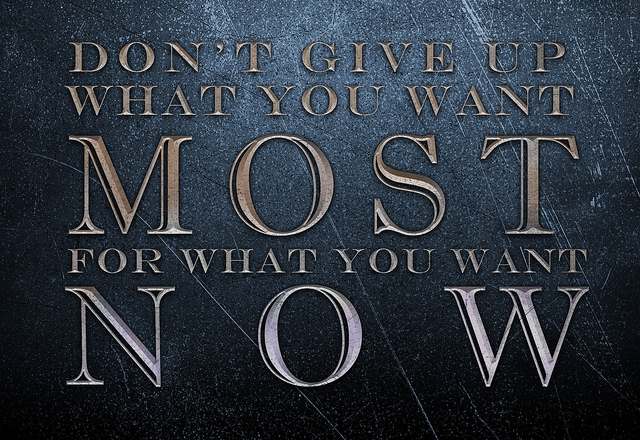|
|
|
Wednesday, June 20th, 2018

I read two articles yesterday. They both focus on how the long-term thinking of Jeff Bezos and Marc Benioff inform their decision making and are well worth your reading.
Bezos is famous for ignoring Wall Street for Amazon’s first two decades.
When it comes to making the most important and the most long-term decisions, Bezos has a simple rule that’s quite useful: “Focus [your vision] on the things that won’t change.”
At Amazon, this means that everything is built around their value of customer obsession.
Benioff has a different approach to making decisions, but still based on the long-term vision he embedded in Salesforce’s culture from the day of founding.
I came back with a clear vision of what the future of the internet was going to be in regards to software-as-a-service and cloud computing. I also had a much deeper sense of my spiritual self. So I said, “When I start a company, I will integrate culture with service.”
When I started Salesforce, on March 8, 1999, I said we’re going to put one percent of our equity, product and time into a foundation and create a culture of service within our company. We’ll be creating new technology, the cloud; we’ll be creating a new business model, subscription services; and we’ll create a culture built on philanthropy.
Last month Warren Buffett, Jamie Dimon and a legion of executives came out publicly against Wall Street’s short-term focus.
The emphasis on quarterly earnings, and the importance of beating estimates, is warping American business and the economy, argue almost 200 CEOs who belong to the Business Roundtable, a lobbying organization. Short-term thinking leads corporations to choke back on hiring, and to starve research and development of the spending the fuels long-term growth. The pressure of quarterly earnings is one reason fewer companies are interested in going pubic, preferring the slower growth that comes with being private than the scrutiny that comes with being listed.
Wall Street’s short-term thinking never got a toe-hold at either Salesforce or Amazon, but the reasons it didn’t created significantly different cultures.
While Benioff’s obsession culminates in giving back, Bezos’ obsession comes at a substantial cost to Amazon warehouse workers, the environment and even society.
Image credit: Scott Ellis
Posted in Culture, Personal Growth, Role Models | No Comments »
Monday, July 24th, 2017
It’s amazing to me, but looking back over more than a decade of writing I find posts that still impress, with information that is as useful now as when it was written.
Golden Oldies are a collection of what I consider some of the best posts during that time.
Companies constantly talk about what they are doing to incentivize productivity and innovation. Incentives are supposed to help drive performance. Recognition is very important as are financial rewards — as long as they are seen as fair. If not, they act more as disincentives, as seen in the first post.
The second focuses on sales incentives.Maximizing revenue generation, AKA, sales, is a top priority for every business, from micro startups through the Fortune 10. Commissions have always played a significant role incentivizing salespeople — until they don’t.
Read other Golden Oldies here.
The Reward Should Fit the Act
 Are you familiar with the saying “let the punishment fit the crime?” Are you familiar with the saying “let the punishment fit the crime?”
It’s a valid approach, but it’s just as true that the reward should fit the action.
A friend of mine works for a Fortune 1000 company in a tech support role. He’s well respected lead tech in his group.
Last year he developed an idea on his own time and gave it to his company.
As a result, he was flown to annual dinner and presented with an award and a $5000 bonus.
Sound impressive?
His idea will save his company $5 million or more each year.
Still impressed?
My friend isn’t.
He has a friend who is very impressed, but that’s because his company doe nothing; no recognition whatsoever.
My friend feels that a $5K reward for saving the company $5M or more every year, while being better than nothing, is still just short of an insult.
Other than being disappointed what’s the fallout?
He likes his job and his boss, so he’s not planning on leaving, but…
He has another idea that he’s not going to bother developing.
He’s still one of the most productive people they have, but that extra edge is gone.
What do you think his employer should have done?
Join me tomorrow for another look at how, to quote another old saying, companies keep cutting off their noses to spite their faces.
Image credit: dinny
Ducks in a Row: Incentive Stupidity Knows No Bounds
 Yesterday I told you how a company squashed my friend’s initiative by giving him a bonus that had no relationship to the value he provided them in annual savings. Yesterday I told you how a company squashed my friend’s initiative by giving him a bonus that had no relationship to the value he provided them in annual savings.
This reminded me of something that happened back in the early 1980s when sales was truly dependent on the skill, relationships and reputations of salespeople.
Another guy friend, another incredibly stupid company.
In a nutshell,
- Guy outsold every salesperson both internally and at the competition. He had years of experience; relationships with customers that didn’t quit and unmatched skill at understanding customers and convincing them that his company (whichever it was) had the best solution available.
- One day guy was called into the CFOs office and told that his commission was being capped.
- He was on track to earn more than the president and that was unacceptable; he asked if they were sure that was the only solution and told yes.
- Guy proceeded to write a resignation letter on a sheet of paper he borrowed from the CFO.
- He left the offices without speaking to anyone.
- By the time he reached home there were three name-your-own-terms offers from competitors on his voicemail.
- He started with his new company the next day.
Over the years I’ve found that actions like these usually come from the company’s bean counters. (In this instance, ‘bean counters’ is definitely a derogatory term.)
Apparently, some bean counters involved never learned to do the math.
In both cases the actual cost was zero, since they were funded from direct actions well beyond anything expected of the employees involved.
The lesson here is that you never cap a commission and the reward for saving $5 million annually should be at least 1% of one year ($50,000) as opposed to .001% ($5,000).
I realize it’s difficult for some financial types, executives and managers to understand, but that is why bonuses and commissions are called incentives—not disincentives.
Image credit: Finsec
Posted in Compensation, Golden Oldies, Motivation, Retention | No Comments »
Monday, April 4th, 2016
It’s amazing to me, but looking back over the last decade of writing I find posts that still impress, with information that is as useful now as when it was written. Golden Oldies is a collection of what I consider some of the best posts during that time.
I wrote this back in 2007. When I first started working I learned that a quarter was three months and that the companies I worked for, and later with, did everything based on that quarter. I thought it was stupid, because very little of real significance can be accomplished in just three months. Over the years I saw how much damage Wall Street’s short-term attitude did to companies, people and the economy. I certainly don’t claim any expertise, but recognition of that damage has really come to the fore, first BlackRock CEO Larry Fink and now Hillary Clinton. Read other Golden Oldies here.
Although I haven’t read The Taboos of Leadership, it supposedly “reveals the rarely discussed realities of leadership–the secrets that leaders just cannot admit to publicly for fear of losing power, self-respect, or even their jobs.” However, the author, Dr. Anthony F. Smith, makes a cogent observation when he says in an essay,
Well, unfortunately, there are no magic pills to becoming a Leader, just like there are no magic pills to losing weight, getting fit, making a million dollars, or shaving 10 strokes off your handicap in golf. Simply stated, becoming a Leader occurs when one exercises the arduous process of effective Leadership, day after day, week after week, and year after year….
What I have observed in my years of studying leaders, is that very few have all the gifts and talents themselves; what many of the great ones do have, is a self awareness of what talents they do have, and the self confidence and security to surround themselves with others who can compliment them, and compensate for their own lack of skills.
I have no idea whether Dr. Smith has all the answers, but he sure defines the biggest problem (red) and (unfortunately) the least likely solution (blue) in the second paragraph.
I don’t believe that any person has all the talents, skills, gifts, abilities, etc., to successfully lead across the board in today’s ultra complex world and even if they do have the awareness and self confidence fewer and fewer have the external security to hire the right people to compensate—by external, I mean enough secure time to create a team that can DO it.
We live in a ridiculous world where Boards, in fear of investors, give CEOs six months to turn around multi-billion dollar companies that have been drifting, if not actually plunging, downwards for years; expect them to do it no matter what the situation or economy; where the slightest miss is considered grounds for firing; and long-term is a quarter.
Even when Wall Street recognizes the need to change a deeply entrenched culture they still demand that it be done in a quarter and analysts not only want perfect visions of future direction, but also exact execution plans, preferably grounded in heavy cost-cutting (read layoffs).
So, like the politicians who once elected spend much of their time fund-raising, CEOs and the senior managers below them spend much of their time focused on immediate numbers, which they must produce quarterly by hook or, more and more frequently, by crook.
Under these circumstances, the real practice of leadership becomes a very iffy proposition.
Posted in Business info | No Comments »
Thursday, August 13th, 2015

Reading/listening/watching the quantity of cyber stuff we all receive, whether by email or social media, is daunting.
It’s worth it, however, because now and then You’ll find a real jewel among all the costume jewelry and plain, old junk.
As I did with this one,
Today, I asked my mentor, a very successful business man in his 70s, what his top 3 tips are for success. He smiled and said, “Read something no one else is reading, think something no one else is thinking, and do something no one else is doing.”
which makes a great mantra for every entrepreneur.
Flickr image credit: Arya Ziai
Posted in Entrepreneurs | No Comments »
Friday, September 5th, 2014
A Friday series exploring Startups and the people who make them go. Read all If the Shoe Fits posts here
 One question I constantly hear from entrepreneurs is “How do I get into an accelerator?” One question I constantly hear from entrepreneurs is “How do I get into an accelerator?”
My response is along the lines of, “Don’t!” And then give them all the reasons I believe that, in most cases, it’s a bad idea.
Few believe me, so I am hoping this TechCrunch post from Ashwin Ramasamy will convince them/you or at least make you think twice.
So a top accelerator [Y Combinator] states that it is a new form of funding. That begets a question “What are they not?”
If the goal of an accelerator is to get a startup funded, then the irony is telling. The goal of a startup is to grow rapidly from an idea to a sustainable business that solves a problem at scale while making money or building usage base. Funding does help in the “grow” part and/or the “rapidly” part. However many startups don’t grow. Here’s where accelerators could and should play a role and most don’t.
I’m on the advisory board of ZOOMPesa, a Toronto, Canada startup, and was very negative when the founder said we had been invited to join an accelerator called MaRS, assuming it was similar to the accelerators here.
Wow; was I wrong!
MaRS is a non-profit, NGO that provides resources beyond anything I’ve seen.
By supporting entrepreneurs and their new ventures, adapting their products & services to larger organizations, and working to make systems more receptive to innovation, MaRS performs a key role in generating positive economic and societal impact, helping improve our daily lives and allowing us to compete as a city, province and nation.
As far as I know, US accelerators have a (typically American) short-term focus of three months, while MaRS is in for the long haul.
- It recognizes that a startup has little chance of becoming a full-blown enterprise, even if it receives seed funding (only around 27% do).
- MaRS mentors have solid backgrounds in various areas, including law and finance, and are available to do more than pass out advice; that’s in addition to the mentors assigned permanently to each startup to provide coaching and a sounding board as needed, as opposed to the “hazy cloud of mentors” that US accelerators offer.
Read the post and compare it to the MaRS website to see the overall differences.
US accelerators seem to deal mostly with startups that are pumping out consumer-focused apps; not exactly things that will bring great benefits to society.
Sadly, I know of no US accelerators comparable to MaRS—if you do please enlighten me.
I ask you, why not here?
Image credit: HikingArtist
Posted in If the Shoe Fits | No Comments »
Wednesday, July 16th, 2014
Would you jump in front of an object moving at 30 mph or better to take a selfie?
Would you do it knowing that not only you, but others could be seriously injured or even killed?
That’ what was happening at this year’s Tour de France.

What drives people to play this kind of Russian roulette and then brag about it?
I doubt they have a death wish or even consider that they might maim or kill someone else.
Do they have any understanding of cause and effect; action and consequences?
Is it “but me” syndrome?
Is it that they just don’t think?
Can they think?
I honestly don’t understand and would appreciate any insights you might have.
Image credit: Jose Been via Business Insider
Posted in How Stupid Can You Get, Personal Growth | No Comments »
Monday, January 27th, 2014

99.9% of people recognize the power of WIIFM (meaning “what’s in it for me” in deference to the .01%).
Even to an early adopter/cynic like me its power can boggle the mind, especially when it moves economic behemoths to switch sides in a bitter debate like climate change.
The latest example of WIIFM in action is Coke.
Today, after a decade of increasing damage to Coke’s balance sheet as global droughts dried up the water needed to produce its soda, the company has embraced the idea of climate change as an economically disruptive force.
Ya think?
Of course, I can think of hundreds of more serious consequences from the global water shortage than a lack of soda pop.
WIIFM also fuels government fraud and, barring sales to the military, there is no fraud target more appealing than Medicare, Medicaid and Social Security.
This is also an area where corporate fraud transcends individual fraud by orders of magnitude.
While politicos love to point to illegal immigrants as a large source of fraud, because blame is most easily placed on those with the least lobbying power, it is, in fact, organized citizens, doctors and the corporate medical world like the HMA hospital chain, which grades its emergency room doctors based on daily hospital admissions—whether needed or not.
Physicians hitting the target to admit at least half of the patients over 65 years old who entered the emergency department were color-coded green. The names of doctors who were close were yellow. Failing physicians were red.
Never underestimate the power of WIIFM.
Flickr image credit: SueKing2011
Posted in Business info, Culture, Ethics | No Comments »
Wednesday, January 15th, 2014

Last month we looked at the economic dichotomy of having a consumer-based economy while simultaneously reducing wages.
Henry Ford understood that paying higher wages was good business.
Ford astonished the world in 1914 by offering a $5 per day wage ($110 today), which more than doubled the rate of most of his workers. (…) The move proved extremely profitable; instead of constant turnover of employees, the best mechanics in Detroit flocked to Ford, bringing their human capital and expertise, raising productivity, and lowering training costs.
Not to mention that a good part of that disposable income was used to buy Ford cars.
Business counters that idea by pointing to all the costs that didn’t exist in 1914 as justification for relentlessly cutting wages and benefits.
But nothing justifies the current minimum wage in many states.
Speaking of a hundred years, it took that long for new research by Zeynep Ton, a business professor at M.I.T.’s Sloan School of Management and author of “The Good Jobs Strategy,” to prove Ford was correct.
For every dollar of increased wages, one retailer that was studied by Fisher brought in $10 more in revenue. For more-understaffed stores in the study, the boost was as high as $28.
Not only doe it affect employees, but apparently higher wages has a halo effect on stock.
Costco pays its workers about $21 an hour; Walmart is just about $13. Yet Costco’s stock performance has thoroughly walloped Walmart’s for a decade.
Ton’s work is of major competitive importance whether you’re a boss in a small business or head up a giant enterprise.
Flickr image credit: ping.fm
Posted in Compensation, Motivation | 1 Comment »
Monday, July 22nd, 2013
 “Troy,” a CEO I work with off and on, sent me a link to an article referencing Netflix Chief Talent Officer Patty McCord’s explanation of why you should immediately fire underperformers to explain (justify) his own actions. “Troy,” a CEO I work with off and on, sent me a link to an article referencing Netflix Chief Talent Officer Patty McCord’s explanation of why you should immediately fire underperformers to explain (justify) his own actions.
McCord’s core advice is to think six months in advance, about what the company can and should do better, which will highlight the people who don’t have the skill set or drive to get there. (…) “I tell an employee I’m going to put you on a performance improvement plan, but the truth is they don’t actually know how to do what I need someone in their job to do. I did my six months out thing and realized she wasn’t qualified, and I put her on a plan even though it’s not an issue of performance, it’s an issue of skill set.”
This was the latest salvo in our ongoing disagreement on managerial responsibility when it comes to people—a subject we vehemently disagree on.
Troy says that young, fast-growth companies have no time to develop their people and when you have a lot of capital and very stringent targets to achieve [Wall Street quarterly reports, ed], you have to think differently.
I say that it’s mostly management’s fault, especially in larger companies like Netflix because they should be growing their people all the time so their skill-set is ready for the challenge; obviously, I’m not referring to those employees who need to be dragged kicking and screaming into their future.
Startups, fast growing and established companies all need to add the right talent to get where they are going.
Good managers assess the situation, current and future, and inform employees regarding their promotional opportunities.
Further, good managers keep them informed of what new skills they will need in the future, as well as the best way to acquire them.
I read about and know personally thousands of good managers who work hard to grow their people, so they are ready for the new challenges coming down the road.
There are also plenty of companies with good programs in place that bad managers won’t use.
Yes, people deserve to know the truth regarding their opportunities and McCord’s approach when termination is the right course is extremely humane—but few companies would spend the resources.
“Instead, I could have told the employee, ‘here’s what I’m going to need six months from now, and here’s the talent and skills I’ll need. Then you tell her, ‘It’s not you. I don’t want you to fail. I don’t want to publicly humiliate you.’”
However, if that person’s actual manager had been doing his/her job the situation McCord describes might never have happened.
That’s the part that Troy doesn’t get.
Upgrading employee skills and adding new ones is an ongoing process that requires better and stronger management skills and more work than McCord’s approach—hers is the easy way out.
During my 40+ years around the workforce there have always been managers who build their people and those who don’t.
- Those who do build understand that people are holistic and it takes more effort to instill cultural understanding and rebuild group morale after someone is terminated than it does to keep upgrading skills.
- Those who don’t build believe that it’s easier to replace than train/build employees.
But demographics are against them. Replacing people will only become harder as the economy improves and the number of working people and their experience continues to go down.
stock.xchng image credit: arte_ram
Posted in Culture, Hiring, Retention | No Comments »
Tuesday, April 16th, 2013
 The geeks and nerds, along with other in-demand knowledge workers, are inheriting, if not the earth, at least viable workplaces. The geeks and nerds, along with other in-demand knowledge workers, are inheriting, if not the earth, at least viable workplaces.
A two-part article in the LA Times (part 1, part 2) provides chapter and verse on how companies are treating those in various functions that are considered replaceable.
All in the name of short-term, Wall Street-demanded profits.
Contrary to the popular image, tech companies aren’t any better.
An article citing Amazon’s vaunted customer focus advises companies to follow the leader in focusing on the long-term.
But Amazon’s treatment of it’s fulfillment and other lower-level employees shows no leadership and its thinking is just as short-term as everyone else’s.
At some point business leadership will come to understand that business is like a three-legged stool—customers, investors and employees.
When one or two legs are wildly out-of-whack with the third the stool falls over.
Maybe not immediately, but Rome didn’t fall in a day, either.
Three points to consider:
- The economy may not turn around in the near-term, but it will eventually.
- Workplace demographics don’t favor companies who, skipping the euphemisms, treat their people like crap.
- Memory improves significantly when the impact is personal.
I look forward to watching these same companies struggle.
Flickr image credit: Laurel Fan
Posted in Culture, Ducks In A Row | 1 Comment »
|
 Subscribe to
Subscribe to
MAPping Company Success
About Miki 
Clarify your exec summary, website, etc.
Have a quick question or just want to chat? Feel free to write or call me at 360.335.8054
The 12 Ingredients of a Fillable Req
CheatSheet for InterviewERS
CheatSheet for InterviewEEs™
Give your mind a rest. Here are 4 quick ways to get rid of kinks, break a logjam or juice your creativity!
Creative mousing
Bubblewrap!
Animal innovation
Brain teaser
The latest disaster is here at home; donate to the East Coast recovery efforts now!
Text REDCROSS to 90999 to make a $10 donation or call 00.733.2767. $10 really really does make a difference and you'll never miss it.
And always donate what you can whenever you can
The following accept cash and in-kind donations: Doctors Without Borders, UNICEF, Red Cross, World Food Program, Save the Children
*/
?>About Miki
About KG
Clarify your exec summary, website, marketing collateral, etc.
Have a question or just want to chat @ no cost? Feel free to write
Download useful assistance now.
Entrepreneurs face difficulties that are hard for most people to imagine, let alone understand. You can find anonymous help and connections that do understand at 7 cups of tea.
Crises never end.
$10 really does make a difference and you’ll never miss it,
while $10 a month has exponential power.
Always donate what you can whenever you can.
The following accept cash and in-kind donations:
|





 Are you familiar with the saying “let the punishment fit the crime?”
Are you familiar with the saying “let the punishment fit the crime?” Yesterday I told you how a company squashed my friend’s initiative by giving him a bonus that had no relationship to the value he provided them in annual savings.
Yesterday I told you how a company squashed my friend’s initiative by giving him a bonus that had no relationship to the value he provided them in annual savings.
 One question I constantly hear from entrepreneurs is “How do I get into an accelerator?”
One question I constantly hear from entrepreneurs is “How do I get into an accelerator?”


 “Troy,” a CEO I work with off and on, sent me a link to an article referencing Netflix Chief Talent Officer Patty McCord’s explanation of
“Troy,” a CEO I work with off and on, sent me a link to an article referencing Netflix Chief Talent Officer Patty McCord’s explanation of  The geeks and nerds, along with other in-demand knowledge workers, are inheriting, if not the earth, at least viable workplaces.
The geeks and nerds, along with other in-demand knowledge workers, are inheriting, if not the earth, at least viable workplaces.
